Septic tank for high groundwater: methods for determining groundwater level and recommendations for choosing a septic tank
In the private sector, there are often situations when there is a centralized water supply system, but there is no sewerage system.In order to use all the necessary plumbing fixtures without problems, you need to take care of drainage and wastewater treatment.
The task becomes more complicated if aquifers are located close to the surface. A solution to the problem can be a septic tank for high groundwater - the device is selected based on an assessment of the geological condition of the site and the expected intensity of operation.
The content of the article:
Purpose and operating features of septic tanks
A well-maintained private home has many plumbing and household appliances that use water: a toilet, a kitchen sink, a washbasin, a bathtub or shower stall, a washing machine. Dishwashers are often also installed.
As a result of all this equipment, large amounts of wastewater are generated.
To dispose of wastewater, the home owner needs to consider an effective sewer system. The good old cesspool is not an option, because... even the largest sealed tank will have to be cleaned frequently, and this is a serious expense for sewage services
Wastewater should be disposed of without harming the environment, and the best choice is a septic tank that provides biological treatment of contaminants.
The purpose of a septic tank is the accumulation, purification and disposal of wastewater. This process occurs in stages in several (usually two or three) chambers.
The first tank is designed to collect wastewater from the sewer system. Primary purification occurs here: the wastewater is stratified, solid particles sink to the bottom, and clarified water with fewer impurities flows into the next chamber.

In the second tank, the fermentation process of sewage continues. Anaerobic bacteria decompose organic compounds and the wastewater continues to be purified. Almost pure water enters the third chamber, the filtration field or the above-ground filter cassette, where additional purification occurs.
What problems arise due to high groundwater level?
If groundwater is close, the septic tank must be absolutely sealed, and its installation must be perfectly correct. Otherwise, two types of problems may occur: the structure will float or it will flood.Let's figure out what this threatens.
When installing a septic tank, it is carefully secured to a concrete pad. If this is not done, during floods or rainstorms it will rise to the ground surface. This will inevitably lead to deformation of the elements of the sewer system, pipe breaks and other troubles. The sewer system will fail.
If an insufficiently reliable septic tank is selected or built for the installation of water treatment, sooner or later groundwater will begin to seep into the structure. This will lead to its flooding. An overfilled tank will stop working properly. But that's not all.

Water may begin to flow into the system through the pipeline. This is fraught with pipe breaks and flooding of building foundations. In some cases, water from a flooded septic tank rises to plumbing fixtures in the home and causes serious damage.
Flowing through the pipes, water carries with it a lot of impurities - from sewage from the septic tank to solid particles (sand, pebbles, garbage). Its chemical composition is extremely aggressive. This can cause corrosion of metal elements, damage to the integrity of pipe coatings and plumbing equipment, and mechanical damage.
All this leads to the rapid destruction of the septic tank itself and all elements of the sewer system. That is why, with a high groundwater level, you cannot save on materials and installation. The stronger and more airtight the structure, the longer the period of trouble-free operation.
Sewage is cleaned due to a large number of microorganisms.If sewage leaks into the aquifer on which wells and boreholes are built, this can result in intestinal (at best) diseases for people and diseases of domestic animals.

High groundwater is not only a risk of accidents, but also a large investment of money, especially if errors were made during installation. Depressurization will cause water to leak into the tank, and it will need to be pumped out more often. Costs for sewerage services will increase sharply.
Another nuance: when designing an autonomous sewer system, it is necessary to immediately think through the drainage system on the site, otherwise the area around the septic tank may become swamped.
Determining the depth of groundwater at the site
The ideal option is to determine the groundwater level using hydrogeological studies. However, they rarely turn to professionals, because... it is expensive, time consuming and difficult. You can find your way on your own, but an ordinary garden drill or folk signs will help.
Option #1: garden auger and rod
To determine the groundwater level, a drill and a rod with a length of 2 m or more are suitable. It is necessary to make marks on the rod for a tape measure. It is not necessary to mark every centimeter; marks at a distance of 5-10 cm are sufficient.
You need to make a hole the length of the drill. It happens that water comes out while drilling. This means that it is very close to the surface. However, more often you have to wait. The well is left for a day to allow water to accumulate in it.
The dry rod is lowered to the bottom of the well.Then they take it out and check to what point it is wet. All that remains is to calculate the results. For example, if the length of the drill is 2 m, and 10 cm of the rod are wet, it turns out that the water lies at a depth of 1.9 m.

Such measurements are carried out not once, but over several days, recording the results each time. If they do not change, it means that the water is located at this depth. If there is a difference, then you should focus on the lowest results. For example, if on different days a depth of 1.9 m and 1.8 m is obtained, then the correct groundwater level is considered to be 1.8 m.
Option #2: determine by plants
Vegetation is often an indicator of the proximity of water. For example, if willow, alder, meadowsweet, and especially reeds grow on the site, then the soil is moist. You can determine the depth in meters from plants using the table below:
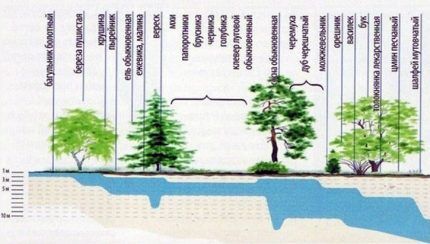
The slope of a maple, birch, or willow tree can indicate exactly where the water comes closest to the surface. It is best to navigate through several trees at once.
Option #3: ponds and wells
There are often small open bodies of water near the site. By the water level in them you can determine how close the aquifer is. If there are swamps, this is a sure sign of high groundwater level.
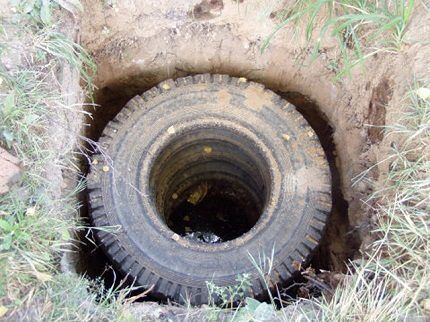
Regular communication with neighbors can also help in determining the depth of groundwater, because they probably had to determine it during the construction of houses, outbuildings, hydraulic structures, and sewage systems.
Option #4: old-fashioned methods
Groundwater level can be determined using an ordinary clay pot. To do this, remove the turf from a small plot of land, place a clump of defatted wool, and a freshly laid egg on top. All this is covered with ceramic dishes and left overnight.
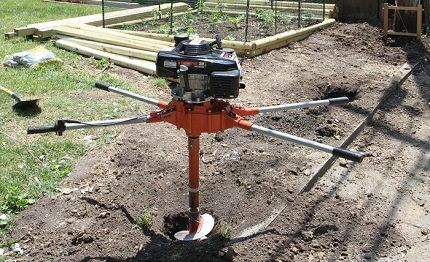
In the morning, it is enough to inspect the wool and egg. If the wool is damp but there is no sign of condensation on the egg, the GWL is low. If the wool is wet and there are droplets of moisture on the egg, then the water obviously comes very close to the surface.
Option #5: folk signs
Routine observations can also be useful in determining groundwater level. For example, heavy morning dew and thick evening fog indicate that water is close to the ground surface. The closer the aquifer, the more obvious these signs are. They can occur even in extreme heat and drought.

Pets behave differently depending on the depth of the water. For example, cats may choose a place to rest where water is close. Dogs, on the contrary, look for the driest place on the site.
With all the disadvantages of a high groundwater level, there is also a big plus. Rodents avoid places with high humidity. This means you will be less likely to be attacked by mice. Ants behave the same way.The absence of anthills in the area may indicate high soil moisture.
Correct septic tank on an area with high groundwater level
In some cases, it makes sense to install a sealed storage tank. This is a kind of analogue of a cesspool. Its peculiarity is that the liquid only accumulates in the container, but is not purified.
Disadvantages: the need for frequent maintenance and high cost. On the other hand, if people do not live in the house permanently, such a sewer system will be profitable and convenient.
Industrial storage septic tanks are made from high-strength materials. The thickness of the tank walls can reach 10-40 mm. There are large volume septic tanks.
Their advantages:
- absolute tightness;
- environmental safety;
- ease of installation;
- durability.
Some models are equipped with sensors that indicate how full the container is.
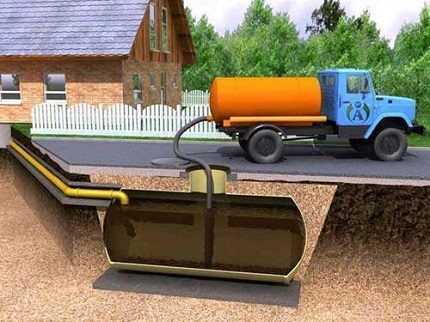
In most cases, the drive does not solve the problem, because... For a comfortable life, home owners need a complete sewer system. In this case, it makes sense to equip a septic tank with a bulk aeration field. The structure must be waterproof. It must be protected from floating and deformation due to soil heaving.
Features of materials for making cameras
There are several suitable materials for constructing a septic tank with high groundwater:
- Reinforced concrete. Volumetric monolithic reinforced concrete structure – ideal for a home where a family of 3 or more people lives.The chambers of such a septic tank do not allow water to pass through, do not float up, cope with the effects of aggressive chemicals and can last for decades.
- Plastic (containers or Eurocubes). Not the most reliable material, but it is suitable for independently installing a septic tank in the country. Pros: tightness, lightness. Disadvantages - the need to provide good protection against floating, the risk of cracks appearing when the soil heaves.
- Fiberglass. The material is highly durable, lightweight, can withstand heavy loads, and withstands chemicals well. The disadvantage is the same as that of plastic: the septic tank must be anchored during installation.
To install a reliable sewerage system, it is best to choose reinforced concrete. The construction of such a septic tank will be quite expensive, but you can forget about the problem of floating.
The structure will not burst if a vehicle accidentally hits it, as can happen with a plastic or fiberglass tank. It is extremely durable and repairable.
Protecting the septic tank from floating and heaving of the soil
Lightweight plastic septic tanks must be fixed, because their weight is not enough to withstand groundwater pressure. They often float up. The technology of anchoring the structure itself is simple, the main thing is to strictly adhere to it.
Work order:
- The bottom of the pit is leveled. A 30 cm thick sand cushion is poured on top and compacted thoroughly.
- Place a base on a layer of sand – reinforced concrete slab according to the size of the structure.
- The septic tank is mounted on a slab, secured with special belts or cables.
To protect against soil heaving, use a dry mixture of sand and cement (5: 1).After installing the septic tank, a gap remains between the structure body and the walls of the pit.
It is desirable that it be at least 15 cm. The mixture is poured into this space in layers, pouring water and compacting each layer.
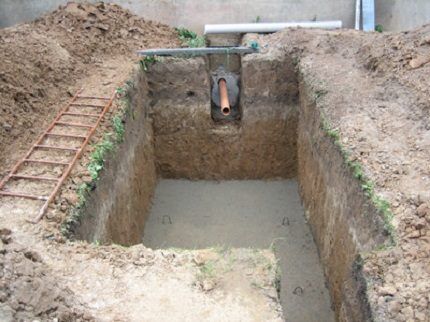
During backfilling, the septic tank tanks are simultaneously filled with water. Moreover, the water level must coincide with the filling level of the pit. This is necessary to equalize the loads and prevent cracks from appearing in the plastic structure.
The device of the above-ground filter cassette
If the groundwater is deep, for post-treatment of wastewater, either filter field, or filter well. In this case, the water moves by gravity, there is no need for forced pumping.
If the groundwater level is high, you need to install an additional waterproof well, pump and filter cassette. Its size is calculated based on the fact that for cleaning 0.5 cubic meters. you need a 1 x 1 m cassette.
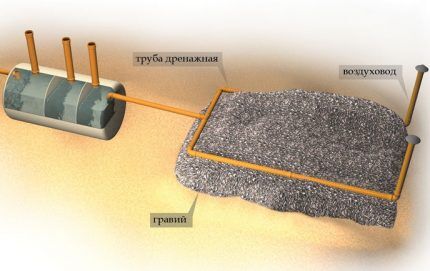
To set up a filter cassette, 30-40 cm of soil is removed from the entire surface of the future structure, and the perimeter is fenced with concrete blocks so that their height is level with the ground.
This space is filled with crushed stone (fraction from 20 to 40 mm), and a tank without a bottom is placed on top, under which a pipe from the septic tank is connected. The structure is insulated and covered with a layer of soil 30 cm thick.
TOP 10 best septic tank manufacturers
If groundwater lies close to the surface, you can choose an industrial septic tank. It is guaranteed to be airtight, the rest depends on the quality of installation.

There are several brands that have proven themselves well in the domestic market:
- "Tank". These are plastic, non-volatile structures with body wall thicknesses of up to 17 mm. They withstand loads well and are resistant to temperature changes. The design is designed so that the tank does not float under the influence of groundwater.
- "Triton". Septic tanks of various sizes and purposes are produced under this brand. When installing the model, you need to anchor it. If they are installed correctly, they can last up to half a century.
- "Leopard". The manufacturer produces energy-dependent and independent models. These are three-chamber septic tanks with two levels of biological filtration. The structures are reliable, strong and durable.
- "Tver". These are reliable systems for comprehensive wastewater treatment. The advantages of septic tanks include compactness, durability, and high throughput. The disadvantage is energy dependence and the need for appropriate maintenance.
- "Leader". Septic tanks consist of six chambers for various purposes. The designs include an airlift and an aerator. Plus: no need to use bioadditives for normal operation of the installation. The system is designed perfectly.
- "Ecopan". One of the best options for installation in clayey and heaving soils with high groundwater levels.The design is designed so that it can withstand heavy loads without the slightest damage or deformation.
- "Unilos". Step-by-step mechanical and biological treatment ensures the safety of the septic tank for the environment. The structures are reliable and easy to maintain, despite the complex algorithm of the wastewater treatment process.
- "Yubas". These septic tanks are not only reliable and durable. They are distinguished by one more advantage: the structures do not lose their performance and efficiency, even if they are used with long breaks (up to 3 months).
- "Poplar". Septic tanks operate in a wide temperature range, are resistant to external influences, and are equipped with aerators, airlifts, and compressors. You can remove waste either using a sewer truck or manually.
- "Topas". Autonomous sewage systems "Topas" are in demand due to their reliability. Although their operating principle is the same as that of other septic tanks, the manufacturer took care of the high quality of materials for the manufacture of their products.
When choosing a specific model of any brand, you should check with the seller for all the details. The septic tank must be durable and strong.
In addition, the installation must purify wastewater as efficiently as possible and be easy to operate.
When purchasing a model, pay attention to energy consumption and the required cleaning frequency. It is also important how long the septic tank remains operational in the event of a power outage and how quickly it returns to standard operating mode.
Conclusions and useful video on the topic
The close occurrence of groundwater can create many problems when installing an autonomous sewer system. We offer useful videos in which you will find many tips and will be able to design and build a system without the help of specialists.
Description of sewerage features at high groundwater level and detailed explanations from the owner of the site:
Excavation work and septic tank installation process - demonstration:
Useful recommendations for DIY sewer construction and a visual demonstration of the process.
Part 1:
Part 2:
The comfort of the residents of the house depends on the quality of the design and installation of the sewer system. If there is a high groundwater level in the area, you should carefully study the technology for installing a septic tank and select the right model. Otherwise, problems are inevitable.
If you doubt your abilities, invite specialists. This will be much cheaper than having to redo an ineffective sewer later.
If you have experience using a septic tank, please share information with our readers. Tell us which model you chose? Leave comments and ask questions on the topic in the form below.




I had this problem when I inherited a house by the river. On the one hand, it’s beautiful, the landscape, nature, but on the other hand, it’s very problematic to provide amenities.
I know firsthand what it is like to build a septic tank incorrectly, my newly installed tank was pushed out by groundwater and the pipes burst, the entire area was covered in “fertilizers.”
I had to do everything wisely a second time, and that’s completely different money.